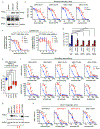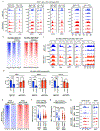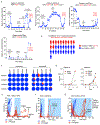MEN1 mutations mediate clinical resistance to menin inhibition
- PMID: 36922589
- PMCID: PMC10157896
- DOI: 10.1038/s41586-023-05755-9
MEN1 mutations mediate clinical resistance to menin inhibition
Abstract
Chromatin-binding proteins are critical regulators of cell state in haematopoiesis1,2. Acute leukaemias driven by rearrangement of the mixed lineage leukaemia 1 gene (KMT2Ar) or mutation of the nucleophosmin gene (NPM1) require the chromatin adapter protein menin, encoded by the MEN1 gene, to sustain aberrant leukaemogenic gene expression programs3-5. In a phase 1 first-in-human clinical trial, the menin inhibitor revumenib, which is designed to disrupt the menin-MLL1 interaction, induced clinical responses in patients with leukaemia with KMT2Ar or mutated NPM1 (ref. 6). Here we identified somatic mutations in MEN1 at the revumenib-menin interface in patients with acquired resistance to menin inhibition. Consistent with the genetic data in patients, inhibitor-menin interface mutations represent a conserved mechanism of therapeutic resistance in xenograft models and in an unbiased base-editor screen. These mutants attenuate drug-target binding by generating structural perturbations that impact small-molecule binding but not the interaction with the natural ligand MLL1, and prevent inhibitor-induced eviction of menin and MLL1 from chromatin. To our knowledge, this study is the first to demonstrate that a chromatin-targeting therapeutic drug exerts sufficient selection pressure in patients to drive the evolution of escape mutants that lead to sustained chromatin occupancy, suggesting a common mechanism of therapeutic resistance.
© 2023. The Author(s), under exclusive licence to Springer Nature Limited.
Conflict of interest statement
S.F.C. is a consultant for and holds equity interest in Imago Biosciences. J.G.D. consults for Microsoft Research, Servier, Abata Therapeutics, Maze Therapeutics, BioNTech, and Pfizer; JGD consults for and has equity in Tango Therapeutics. J.G.D. receives support via the Functional Genomics Consortium (Merck, Abbvie, Janssen, Vir, and Bristol Meyers Squibb). R.L.L. is on the supervisory board of Qiagen and is a scientific advisor to Loxo, Imago, C4 Therapeutics and Isoplexis. He receives research support from and consulted for Celgene and Roche, research support from Prelude Therapeutics, and has consulted for Novartis and Gilead. He has received honoraria from Lilly and Amgen for invited lectures. E.M.S. receives research support to his institution from Agios, Amgen, Astellas, Bayer, Biotheryx, Bristol Myers Squibb, Eisai Foghorn, Servier, Syndax, Syros and consulting fees from Novartis, PinotBio, Janssen, Bristol Myers Squibb, Agios, Jazz, Menarini, Genentech, Genesis, Abbvie, Neoleukin, Gilead, Syndax, OnCusp, CTI Biopharma, Foghorn, Servier, Calithera, Daiichi, Aptose, Syros, Astellas, Ono Pharma, Blueprint, Kura. Epizyme and Cellectis. E.M.S. also holds equity interest in Auron Therapeutics.
S.A.A. has been a consultant and/or shareholder for Vitae/Allergan Pharmaceuticals, Neomorph, Inc., Imago Biosciences, Cyteir Therapeutics, C4 Therapeutics, and Accent Therapeutics. S.A.A. has received research support from Janssen, and Syndax and is an inventor on a patent related to Menin Inhibition WO/2017/132398A1. J.D.C. is a current member of the Scientific Advisory Boards of OpenEye Scientific Software, Interline Therapeutics, and Redesign Science. The Chodera laboratory receives or has received funding from the National Institute of Health, the National Science Foundation, the Parker Institute for Cancer Immunotherapy, Relay Therapeutics, Entasis Therapeutics, Silicon Therapeutics, EMD Serono (Merck KGaA), AstraZeneca, Vir Biotechnology, XtalPi, Interline Therapeutics, and the Molecular Sciences Software Institute, the Starr Cancer Consortium, the Open Force Field Consortium, Cycle for Survival, a Louis V. Gerstner Young Investigator Award, and the Sloan Kettering Institute. A complete funding history for the Chodera lab can be found at
Figures














Comment in
-
Investigating menin inhibitor action in leukaemia.Nat Rev Drug Discov. 2023 May;22(5):352. doi: 10.1038/d41573-023-00055-3. Nat Rev Drug Discov. 2023. PMID: 37016125 No abstract available.
References
-
- Kuhn MW et al. Targeting Chromatin Regulators Inhibits Leukemogenic Gene Expression in NPM1 Mutant Leukemia. Cancer discovery 6, 1166–1181 (2016). 10.1158/2159-8290.CD-16-0237 - DOI - PMC - PubMed
Publication types
MeSH terms
Substances
Grants and funding
- R01 CA173636/CA/NCI NIH HHS/United States
- T32 HL007574/HL/NHLBI NIH HHS/United States
- P50 CA206963/CA/NCI NIH HHS/United States
- F32 CA250240/CA/NCI NIH HHS/United States
- P30 CA008748/CA/NCI NIH HHS/United States
- R35 CA197594/CA/NCI NIH HHS/United States
- R01 CA176745/CA/NCI NIH HHS/United States
- K08 CA267058/CA/NCI NIH HHS/United States
- R01 CA214608/CA/NCI NIH HHS/United States
- R01 GM121505/GM/NIGMS NIH HHS/United States
- K08 CA241371/CA/NCI NIH HHS/United States
- F32CA250240-02/CA/NCI NIH HHS/United States
- R01 CA204639/CA/NCI NIH HHS/United States
- CA066966/CA/NCI NIH HHS/United States
- P01 CA066996/CA/NCI NIH HHS/United States
LinkOut - more resources
Full Text Sources
Other Literature Sources
Medical
Molecular Biology Databases

